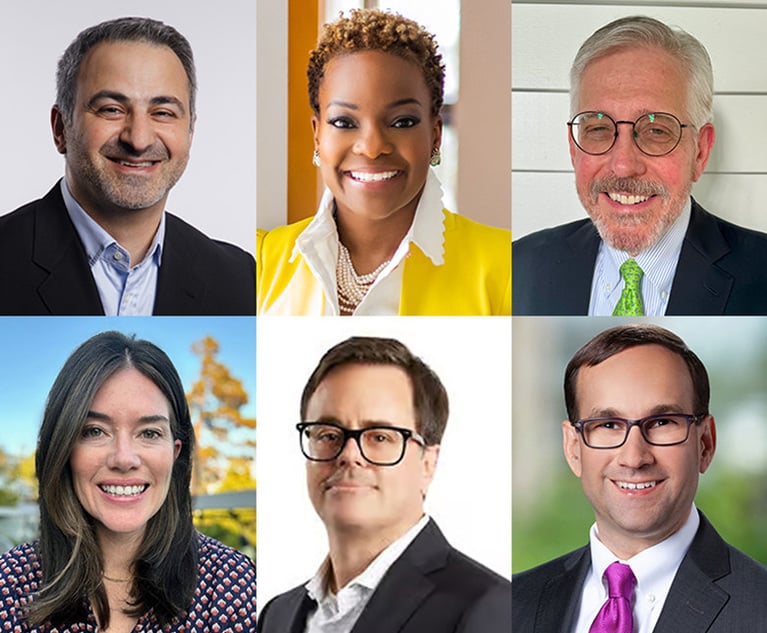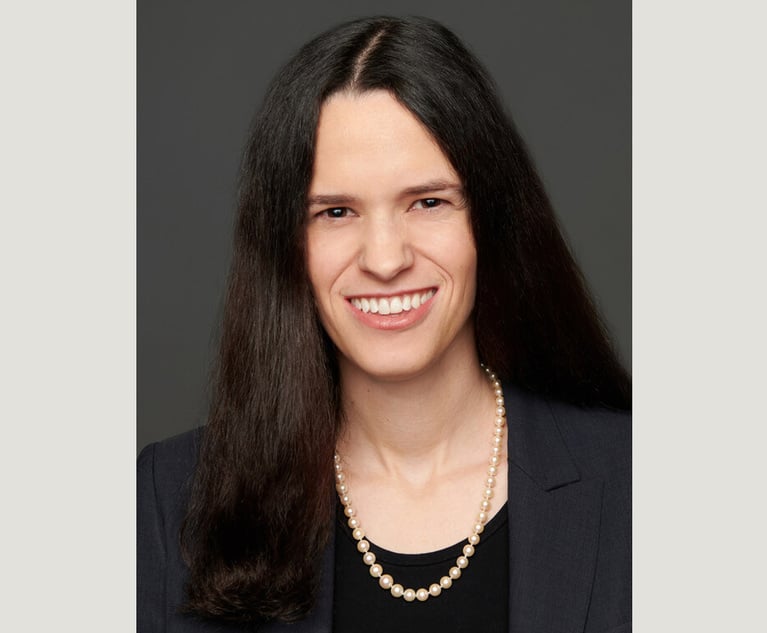IP: Value in the backwaters of patent law
In a nod to patent harmonization, the U.S. acceded to the dominant world view when it adjusted the definition of patent term by passing into law the 1994 Uruguay Round Agreements Act (URAA).
December 25, 2012 at 02:30 AM
14 minute read
The original version of this story was published on Law.com
In a nod to patent harmonization, the U.S. acceded to the dominant world view when it adjusted the definition of patent term by passing into law the 1994 Uruguay Round Agreements Act (URAA). Under the URAA, patent term extends from patent issuance to 20 years from the filing date of the underlying patent application, thus providing a variable patent term dependent on issuance date. Previously, the U.S. had simply defined patent term as 17 years from patent issuance. The effective term of a U.S. patent under the current definition will equal the old term of 17 years from issuance when the application spends three years in U.S. Patent and Trademark Office (USPTO) examination. It is the rare U.S. patent application that is under examination for exactly three years, and those in the business and patenting communities are aware that the typical application is examined for longer, and often significantly longer, than three years. To mitigate the potential loss of term due to examination delay, Congress in 1994, and again in 1999, provided for patent term adjustment. Despite the time that has passed, the courts have recently issued some significant decisions interpreting the statute providing for term adjustment, as highlighted below.
- Patent term adjustment determinations are complicated
- Compensations for distinct delays are added
- After three years of examination, it's mostly gravy
The statutory scheme for term adjustment created by Congress, codified at 35 USC § 154, is not a model of clarity. Implementation of that scheme by the USPTO exercising its rulemaking authority did little to clarify the situation. That lack of clarity, coupled to the starchy bookkeeping nature of determining proper adjustments, has undoubtedly contributed to the decade-long delay in resolving the finer points of the law. Two recent federal district court decisions, Exelixis, Inc. v. Kappos and Novartis AG v. Kappos, along with the Wyeth v. Kappos decision a couple of years ago, have opened eyes to the value of ensuring that a patent receives its full term adjustment, particularly in fields such as pharmaceuticals and biotechnology that can reap significant rewards at the end of patent terms. Appreciating the import of these decisions will be aided by a brief look at the governing statute.
The definition of patent term as extending from patent issuance to 20 years from the application filing date is laid out in straightforward fashion in § 154(a). Things begin to get a little fuzzy, however, in subsection (b). Section 154(b)(1) provides the government's adjustment guarantees, and § 154(b)(2) enumerates limitations on those guarantees. There are several specific guarantees in § 154(b)(1), each compensable on a day-for-day basis for any delay by the USPTO, but the recent court cases and this article focus on five. Section 154(b)(1)(A) provides four guarantees for particular USPTO delays. Time beyond 14 months taken by the USPTO to initially communicate regarding a filed application is compensable delay, as is any time beyond four months for the USPTO to respond to action by the applicant, the Patent Trial and Appeal Board, or a court. These specific delays are often referred to as “A” delays. Section 154(b)(1)(B) provides a remedy for any application pendency beyond three years, referred to as a “B” delay. Before turning to the limitations in § 154(b)(2), it's worth noting § 154(b)(1)(B) itself defines a limitation in establishing that compensable “B” delays are tolled by filing a request for continued examination (RCE) within the three-year examination window. Section 154(b)(2)provides the remaining limitations on compensable delays by the USPTO, including the lack of compensation for lack of effort by the applicant to reasonably conclude the examination process, for overlaps in delay periods (i.e., no double-counting), and for any time beyond the actual number of days of delay. Finally, the statute provides for a 180-day period in which to bring a civil action in the Eastern District of Virginia challenging the adjustment determination. The recent cases have provided significant pro-patentee interpretations of the statutory scheme.
In the 2010 Wyeth case, the court considered possible overlap between “A” delays and the “B” delay. The USPTO took the position that any “A” delay necessarily pushed back the date of patent issuance, and this push-back period should not be double-counted by inclusion in the “B” delay. According to the USPTO, then, any compensation for “B” delay should be net of any “A” delay. The contrary position, adopted by the court, was that “A” delays occurring within the first three years of examination, as found in Wyeth, could not overlap with any “B” delay because the period for “B” delay didn't even begin until three years into examination. As a consequence, the “A” and “B” delays in Wyeth were added, resulting in a gain of 294 and 486 days of term for the two patents-in-issue, during which Wyeth could continue to enjoy its position of advantage in an Alzheimer's disease market estimated at $160 billion annually in 2010.
In November, the Eastern District of Virginia in Exelixis v. Kappos addressed the issue of whether delays beyond the three-year examination term would be tolled by filing an RCE after the three-year anniversary. The statute expressly provides that compensable delay is tolled by filing an RCE within the three-year period of examination, but the USPTO had promulgated a rule (37 CFR § 1.703(b)) cutting off compensable delay whenever an RCE is filed. The court held that the statute limited the tolling effect of RCEs to those RCEs filed within the first three years of examination, meaning that the filing of an RCE more than three years after filing the application would not stop the clock on compensable delay. For Exelixis and its anti-cancer therapeutic, the proper determination adds 114 days of exclusivity for its therapeutic in the $157 billion dollar annual cancer treatment market.
The district court for Washington, D.C., followed Exelixis in deciding Novartis AG v. Kappos. Going beyond affirming that RCEs filed three or more years into examination would not halt compensation for USPTO delays, the Novartis AG court held that requests for reconsideration of patent term adjustment timely filed in the USPTO would toll the 180-day period for seeking redress by civil action. Some commentators have urged caution regarding this aspect of the Novartis AG decision, noting that the statute expressly provides for appeal of patent term adjustment by civil action in the Eastern District of Virginia. The important point here is that the 180-day clock begins ticking upon patent issuance, and there may be issued patents of sufficient value to justify court action to obtain the full measure of compensable delay.
Court interpretations of patent term adjustment have revealed that “A” delays within the first three years of examination are added to any “B” delays and RCEs filed after those first three years will not cut off adjustments for USPTO delays, both benefitting the patentee. Even without raising the specter of renewed Lemelson-style submarine patents, the corrected adjustments to patent term could prove valuable enough to pay close heed to adjustment calculations. With Wyeth's patent drawn to an Alzheimer's disease treatment and Exelixis' patent protecting an anti-cancer treatment, each day of adjusted term promises to add significant value.
DISCLAIMER: The information contained in this article is for informational purposes only and is not legal advice or a substitute for obtaining legal advice from an attorney. Views expressed are those of the author and are not to be attributed to Marshall, Gerstein & Borun LLP or any of its former, present or future clients.
In a nod to patent harmonization, the U.S. acceded to the dominant world view when it adjusted the definition of patent term by passing into law the 1994 Uruguay Round Agreements Act (URAA). Under the URAA, patent term extends from patent issuance to 20 years from the filing date of the underlying patent application, thus providing a variable patent term dependent on issuance date. Previously, the U.S. had simply defined patent term as 17 years from patent issuance. The effective term of a U.S. patent under the current definition will equal the old term of 17 years from issuance when the application spends three years in U.S. Patent and Trademark Office (USPTO) examination. It is the rare U.S. patent application that is under examination for exactly three years, and those in the business and patenting communities are aware that the typical application is examined for longer, and often significantly longer, than three years. To mitigate the potential loss of term due to examination delay, Congress in 1994, and again in 1999, provided for patent term adjustment. Despite the time that has passed, the courts have recently issued some significant decisions interpreting the statute providing for term adjustment, as highlighted below.
- Patent term adjustment determinations are complicated
- Compensations for distinct delays are added
- After three years of examination, it's mostly gravy
The statutory scheme for term adjustment created by Congress, codified at 35 USC § 154, is not a model of clarity. Implementation of that scheme by the USPTO exercising its rulemaking authority did little to clarify the situation. That lack of clarity, coupled to the starchy bookkeeping nature of determining proper adjustments, has undoubtedly contributed to the decade-long delay in resolving the finer points of the law. Two recent federal district court decisions, Exelixis, Inc. v. Kappos and
The definition of patent term as extending from patent issuance to 20 years from the application filing date is laid out in straightforward fashion in § 154(a). Things begin to get a little fuzzy, however, in subsection (b). Section 154(b)(1) provides the government's adjustment guarantees, and § 154(b)(2) enumerates limitations on those guarantees. There are several specific guarantees in § 154(b)(1), each compensable on a day-for-day basis for any delay by the USPTO, but the recent court cases and this article focus on five. Section 154(b)(1)(A) provides four guarantees for particular USPTO delays. Time beyond 14 months taken by the USPTO to initially communicate regarding a filed application is compensable delay, as is any time beyond four months for the USPTO to respond to action by the applicant, the Patent Trial and Appeal Board, or a court. These specific delays are often referred to as “A” delays. Section 154(b)(1)(B) provides a remedy for any application pendency beyond three years, referred to as a “B” delay. Before turning to the limitations in § 154(b)(2), it's worth noting § 154(b)(1)(B) itself defines a limitation in establishing that compensable “B” delays are tolled by filing a request for continued examination (RCE) within the three-year examination window. Section 154(b)(2)provides the remaining limitations on compensable delays by the USPTO, including the lack of compensation for lack of effort by the applicant to reasonably conclude the examination process, for overlaps in delay periods (i.e., no double-counting), and for any time beyond the actual number of days of delay. Finally, the statute provides for a 180-day period in which to bring a civil action in the Eastern District of
In the 2010 Wyeth case, the court considered possible overlap between “A” delays and the “B” delay. The USPTO took the position that any “A” delay necessarily pushed back the date of patent issuance, and this push-back period should not be double-counted by inclusion in the “B” delay. According to the USPTO, then, any compensation for “B” delay should be net of any “A” delay. The contrary position, adopted by the court, was that “A” delays occurring within the first three years of examination, as found in Wyeth, could not overlap with any “B” delay because the period for “B” delay didn't even begin until three years into examination. As a consequence, the “A” and “B” delays in Wyeth were added, resulting in a gain of 294 and 486 days of term for the two patents-in-issue, during which Wyeth could continue to enjoy its position of advantage in an Alzheimer's disease market estimated at $160 billion annually in 2010.
In November, the Eastern District of
The district court for Washington, D.C., followed Exelixis in deciding
Court interpretations of patent term adjustment have revealed that “A” delays within the first three years of examination are added to any “B” delays and RCEs filed after those first three years will not cut off adjustments for USPTO delays, both benefitting the patentee. Even without raising the specter of renewed Lemelson-style submarine patents, the corrected adjustments to patent term could prove valuable enough to pay close heed to adjustment calculations. With Wyeth's patent drawn to an Alzheimer's disease treatment and Exelixis' patent protecting an anti-cancer treatment, each day of adjusted term promises to add significant value.
DISCLAIMER: The information contained in this article is for informational purposes only and is not legal advice or a substitute for obtaining legal advice from an attorney. Views expressed are those of the author and are not to be attributed to
This content has been archived. It is available through our partners, LexisNexis® and Bloomberg Law.
To view this content, please continue to their sites.
Not a Lexis Subscriber?
Subscribe Now
Not a Bloomberg Law Subscriber?
Subscribe Now
NOT FOR REPRINT
© 2025 ALM Global, LLC, All Rights Reserved. Request academic re-use from www.copyright.com. All other uses, submit a request to [email protected]. For more information visit Asset & Logo Licensing.
You Might Like
View All
Advertising Tech Likely to Draw More Scrutiny in 2025 Over Consumers' Data, Lawyers Say
5 minute read

'Be Comfortable Being Uncomfortable': Pearls of Wisdom From 2024 GC Q&As

In-House Moves of the Month: Boeing Loses Another Lawyer, HubSpot Legal Chief Out After 2 Years
5 minute readTrending Stories
- 1Judge's Suicide Sparks Chatter Over Judicial Election
- 2Ogletree Deakins Elects Most New Shareholders in Decades
- 3Legal Malpractice: Texas Supreme Court OKs 'Pernicious Distortion of Positions'
- 4Pa. Appeals Court: Trial Judge Dismissed Med Mal Claims Without Giving Plaintiffs Proper Time to Fight Back
- 5Ex-Six Flags CLO Lands New C-Suite Post—This Time as HR Chief
Who Got The Work
Michael G. Bongiorno, Andrew Scott Dulberg and Elizabeth E. Driscoll from Wilmer Cutler Pickering Hale and Dorr have stepped in to represent Symbotic Inc., an A.I.-enabled technology platform that focuses on increasing supply chain efficiency, and other defendants in a pending shareholder derivative lawsuit. The case, filed Oct. 2 in Massachusetts District Court by the Brown Law Firm on behalf of Stephen Austen, accuses certain officers and directors of misleading investors in regard to Symbotic's potential for margin growth by failing to disclose that the company was not equipped to timely deploy its systems or manage expenses through project delays. The case, assigned to U.S. District Judge Nathaniel M. Gorton, is 1:24-cv-12522, Austen v. Cohen et al.
Who Got The Work
Edmund Polubinski and Marie Killmond of Davis Polk & Wardwell have entered appearances for data platform software development company MongoDB and other defendants in a pending shareholder derivative lawsuit. The action, filed Oct. 7 in New York Southern District Court by the Brown Law Firm, accuses the company's directors and/or officers of falsely expressing confidence in the company’s restructuring of its sales incentive plan and downplaying the severity of decreases in its upfront commitments. The case is 1:24-cv-07594, Roy v. Ittycheria et al.
Who Got The Work
Amy O. Bruchs and Kurt F. Ellison of Michael Best & Friedrich have entered appearances for Epic Systems Corp. in a pending employment discrimination lawsuit. The suit was filed Sept. 7 in Wisconsin Western District Court by Levine Eisberner LLC and Siri & Glimstad on behalf of a project manager who claims that he was wrongfully terminated after applying for a religious exemption to the defendant's COVID-19 vaccine mandate. The case, assigned to U.S. Magistrate Judge Anita Marie Boor, is 3:24-cv-00630, Secker, Nathan v. Epic Systems Corporation.
Who Got The Work
David X. Sullivan, Thomas J. Finn and Gregory A. Hall from McCarter & English have entered appearances for Sunrun Installation Services in a pending civil rights lawsuit. The complaint was filed Sept. 4 in Connecticut District Court by attorney Robert M. Berke on behalf of former employee George Edward Steins, who was arrested and charged with employing an unregistered home improvement salesperson. The complaint alleges that had Sunrun informed the Connecticut Department of Consumer Protection that the plaintiff's employment had ended in 2017 and that he no longer held Sunrun's home improvement contractor license, he would not have been hit with charges, which were dismissed in May 2024. The case, assigned to U.S. District Judge Jeffrey A. Meyer, is 3:24-cv-01423, Steins v. Sunrun, Inc. et al.
Who Got The Work
Greenberg Traurig shareholder Joshua L. Raskin has entered an appearance for boohoo.com UK Ltd. in a pending patent infringement lawsuit. The suit, filed Sept. 3 in Texas Eastern District Court by Rozier Hardt McDonough on behalf of Alto Dynamics, asserts five patents related to an online shopping platform. The case, assigned to U.S. District Judge Rodney Gilstrap, is 2:24-cv-00719, Alto Dynamics, LLC v. boohoo.com UK Limited.
Featured Firms
Law Offices of Gary Martin Hays & Associates, P.C.
(470) 294-1674
Law Offices of Mark E. Salomone
(857) 444-6468
Smith & Hassler
(713) 739-1250






